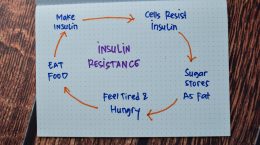Published on April 1, 2024
The amount of vitamin D needed on a daily basis can vary depending on weight. Could it also be that vitamin D levels directly influence weight and the risk of being obese?
Key Points
- The more fat a person has on their body (the higher the BMI), the more likely they are to have vitamin D deficiency, and their need for vitamin D increases; could it also be that vitamin D levels directly influence weight and the risk of being obese?
- A new video “Why Are There No Fat People in Colorado,” by Dr. Eric Berg, DC, discusses findings published in a book by Jeff T. Bowles titled “Why Are There No Fat People In Colorado? & 15 Similar Fascinating Health Mysteries” discussing this topic and more
- Don’t ever consider a situation too late to take steps for correcting or avoiding vitamin D deficiency; measuring your vitamin D level and calculating a supplementation amount to help reach and maintain a target level could possibly make all the difference in your health and how a current disease situation progresses
 Evidence shows that vitamin D levels are affected by obesity. In fact, the more fat a person has on their body (the higher the BMI), the more likely they are to have vitamin D deficiency, and their need for vitamin D increases. This is one reason suggesting the same daily intake of vitamin D for all adults simply does not make sense. In fact, the amount of vitamin D needed on a daily basis to achieve a vitamin D level of 40 ng/ml (100 nmol/L) can vary depending on BMI.
Evidence shows that vitamin D levels are affected by obesity. In fact, the more fat a person has on their body (the higher the BMI), the more likely they are to have vitamin D deficiency, and their need for vitamin D increases. This is one reason suggesting the same daily intake of vitamin D for all adults simply does not make sense. In fact, the amount of vitamin D needed on a daily basis to achieve a vitamin D level of 40 ng/ml (100 nmol/L) can vary depending on BMI.
Could it also be that vitamin D levels directly influence weight and the risk of being obese?
The video “Why Are There No Fat People in Colorado,” by Dr. Eric Berg, DC, discusses findings published in a book by Jeff T. Bowles titled “Why Are There No Fat People In Colorado? & 15 Similar Fascinating Health Mysteries.”
Watch the Video
Key Points from the Video
Areas of the US with higher Black, Latino, and American Indian populations have higher obesity rates. Learn more
The elderly have higher rates of obesity as well. Learn more
People with darker skin tones have more melanin, making it more difficult to absorb vitamin D. It also becomes more difficult to absorb vitamin D as you age. Learn more
Chronic vitamin D deficiency can lead to obesity. The more overweight a person is, the more vitamin D they need. Learn more
The characteristics of metabolic syndrome align perfectly with the symptoms of vitamin D deficiency. Vitamin D deficiency can create inflammation, high blood glucose, high blood pressure, and insulin resistance. Learn more
Insulin resistance is the driving factor behind obesity. If you have insulin resistance, you have too much insulin. Insulin is a fat-storing hormone that causes you to gain weight. Vitamin D helps keep insulin sensitive, but vitamin D doesn’t work well if you have insulin resistance. Learn more
Colorado is a high-altitude state situated several thousand feet above sea level. This means it’s closer to the sun. The closer you are to the sun, the more vitamin D you’re exposed to. Learn more
Vitamin D exposure in Colorado could be the most critical variable influencing people’s weight.
Vitamin D is an Easily Modifiable Factor to Help Improve Disease Outcomes – What Vitamin D Level do YOU Have?
Don’t ever consider a situation too late to take steps for correcting or avoiding vitamin D deficiency. Measuring your vitamin D level and calculating a supplementation amount to help reach and maintain a target level, or taking loading doses to correct deficiency faster, could possibly make all the difference in your health and how a current disease situation progresses.
 Create your custom home blood spot kit by adding any of the following measurements, along with your vitamin D:
Create your custom home blood spot kit by adding any of the following measurements, along with your vitamin D:
- Magnesium PLUS Elements
- Omega-3 Fatty Acids
- hsCRP (for Inflammation)
- HbA1c (for Blood Sugar)
- and more
Having and maintaining healthy vitamin D levels and other nutrient levels can help improve your health and the health of your baby, now and for the future. Enroll and test your levels today, learn what steps to take to improve your status of vitamin D (see below) and other nutrients and blood markers, and take action! By enrolling in the GrassrootsHealth projects, you are not only contributing valuable information to everyone, you are also gaining knowledge about how you could improve your own health through measuring and tracking your nutrient status, and educating yourself on how to improve it.






